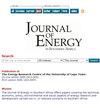The extent, characteristics and potential of solar powered irrigation systems in South Africa
IF 0.6
4区 工程技术
Q4 ENERGY & FUELS
引用次数: 1
Abstract
South Africa has been identified as having a high potential for solar powered irrigation. However, there has been a lag in the development of solar powered irrigation systems (SPIS) there, mainly due to the high investment cost associated with solar technology. South Africa has frequently implemented load shedding, which has affected many farmers. The work reported in this paper sought to determine the extent of solar powered irrigation and characteristics of the system types in use. The extent of SPIS in South Africa was determined using a questionnaire, and categorised in terms of farm size, SPIS configuration (storage of energy), type of irrigation, and location of the system. These were established mainly from a literature search. The questionnaires were administered on Survey Monkey®. The sample size of the study was 138 755 potential respondents. The number that participated and completed the questionnaires included a total of 18 SPIS engineers, installers and designers and 13 SPIS users (farmers). The main problem encountered with the distribution of the survey was finding SPIS users to participate. Results from SPIS engineers, installers and designers showed that most SPIS they implemented were in the Western Cape and the Eastern Cape, at 33% of the responses for both provinces. The total area under SPIS was found to be 364 ha, while the area under irrigation is South Africa is 1 300 00 ha, indicating a high potential for SPIS development. Some details on the extent of SPIS in South Africa were determined in this paper, but more SPIS users need to be identified to determine the details of their SPIS.南非太阳能灌溉系统的范围、特点和潜力
南非被认为在太阳能灌溉方面具有很高的潜力。然而,那里的太阳能灌溉系统发展滞后,主要是由于与太阳能技术相关的高投资成本。南非经常实施减载,这影响了许多农民。本文所报告的工作旨在确定太阳能灌溉的范围和所使用的系统类型的特点。通过问卷调查确定了南非SPIS的范围,并根据农场规模、SPIS配置(能量储存)、灌溉类型和系统位置进行了分类。这些主要是通过文献检索建立起来的。问卷是在Survey Monkey®上进行的。该研究的样本量为138755名潜在受访者。参与和完成问卷的人数包括18名SPIS工程师、安装人员和设计人员,以及13名SPIS用户(农民)。分发调查时遇到的主要问题是寻找SPIS用户参与。SPIS工程师、安装人员和设计人员的调查结果显示,他们实施的大多数SPIS都在西开普省和东开普省,这两个省的回复率均为33%。SPIS的总面积为364公顷,而南非的灌溉面积为13万公顷,表明SPIS的发展潜力很大。本文确定了南非SPIS范围的一些细节,但需要确定更多的SPIS用户以确定其SPIS的细节。
本文章由计算机程序翻译,如有差异,请以英文原文为准。
求助全文
约1分钟内获得全文
求助全文
来源期刊

Journal of Energy in Southern Africa
ENERGY & FUELS-
CiteScore
3.00
自引率
0.00%
发文量
16
审稿时长
6 months
期刊介绍:
The journal has a regional focus on southern Africa. Manuscripts that are accepted for consideration to publish in the journal must address energy issues in southern Africa or have a clear component relevant to southern Africa, including research that was set-up or designed in the region. The southern African region is considered to be constituted by the following fifteen (15) countries: Angola, Botswana, Democratic Republic of Congo, Lesotho, Malawi, Madagascar, Mauritius, Mozambique, Namibia, Seychelles, South Africa, Swaziland, Tanzania, Zambia and Zimbabwe.
Within this broad field of energy research, topics of particular interest include energy efficiency, modelling, renewable energy, poverty, sustainable development, climate change mitigation, energy security, energy policy, energy governance, markets, technology and innovation.
 求助内容:
求助内容: 应助结果提醒方式:
应助结果提醒方式:


